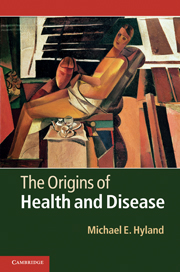Book contents
- Frontmatter
- Contents
- List of figures
- List of tables
- List of boxes
- Acknowledgements
- 1 The two philosophies: health, disease, medicine and psychotherapy
- 2 The body's mind: psychoneuroimmunology, stress and adaptive response
- 3 Personality, disease and the meaning of infornet dysregulation
- 4 Networks and their properties
- 5 The causes of dysregulation: associative learning, food intolerance and the effects of stress throughout the lifespan
- 6 The causes of dysregulation: supervised learning, repetitive strain injury, attention-deficit/hyperactivity disorder, chronic fatigue syndrome and depression
- 7 The causes of dysregulation: asthma and precursors to specific disease
- 8 Three different types of psychologically mediated therapy: placebos and the art of medicine, psychotherapy and complementary and alternative medicine
- 9 Therapeutic mechanisms
- 10 Finding the pattern: health in modern society
- 11 Infornet theory in perspective
- References
- Index
10 - Finding the pattern: health in modern society
Published online by Cambridge University Press: 05 June 2012
- Frontmatter
- Contents
- List of figures
- List of tables
- List of boxes
- Acknowledgements
- 1 The two philosophies: health, disease, medicine and psychotherapy
- 2 The body's mind: psychoneuroimmunology, stress and adaptive response
- 3 Personality, disease and the meaning of infornet dysregulation
- 4 Networks and their properties
- 5 The causes of dysregulation: associative learning, food intolerance and the effects of stress throughout the lifespan
- 6 The causes of dysregulation: supervised learning, repetitive strain injury, attention-deficit/hyperactivity disorder, chronic fatigue syndrome and depression
- 7 The causes of dysregulation: asthma and precursors to specific disease
- 8 Three different types of psychologically mediated therapy: placebos and the art of medicine, psychotherapy and complementary and alternative medicine
- 9 Therapeutic mechanisms
- 10 Finding the pattern: health in modern society
- 11 Infornet theory in perspective
- References
- Index
Summary
Introduction
Infornet theory proposes that the body self-organises to achieve the state defined by the genome. As a result, people should be healthiest (i.e., with a well-regulated infornet) when their lifestyle corresponds to the pattern that is specified in their genome. This hypothesis leads to the following questions: What is that pattern specified in the genome? How do our genes expect us to live?
A simple application of evolutionary theory and genetics suggests that humans are healthiest when their pattern of living corresponds most closely to the circumstances under which they evolved. Anatomically, modern humans have evolved over long period of time but they existed in their present form some 100,000 years ago. Humans evolved in an environment that was different in a number of respects from the modern environment. According to the simple view, the genetic determinants of a modern healthy lifestyle can be understood in terms of a Palaeolithic lifestyle some one hundred thousand to ten thousand years ago. The Upper Palaeolithic (‘old stone age’) occurred during the last ice age, and the Upper Palaeolithic people lived a life of hunter-gatherers. By contrast the Neolithic people (‘new stone age’) lived after the end of the last ice age and were farmers. The growing of crops and domestication of animals developed simultaneously in several parts of the world from about 10,000 years ago onwards.
- Type
- Chapter
- Information
- The Origins of Health and Disease , pp. 280 - 303Publisher: Cambridge University PressPrint publication year: 2011

